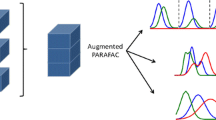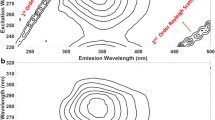Abstract
The use of the successive projections algorithm (SPA) for elimination of uninformative variables in interval selection, and unfold partial least squares regression (U-PLS) modeling of excitation-emission matrices (EEM), when under the inner filter effect (IFE) is reported for first time. Post-calibration residual bilinearization (RBL) was employed against events of unknown components in the test samples. The inner filter effect can originate changes in both the shape and intensity of analyte spectra, leading to trilinearity losses in both modes, and thus invalidating most multiway calibration methods. The algorithm presented in this paper was named iSPA-U-PLS/RBL. Both simulated and experimental data sets were used to compare the prediction capability during: (1) simulated EEM; and (2) quantitation of phenylephrine (PHE) in the presence of paracetamol (PAR) (or acetaminophen) in water samples. Test sets containing unexpected components were built in both systems [a single interference was taken into account in the simulated data set, while water samples were added with varying amounts of ibuprofen (IBU), and acetyl salicylic acid (ASA)]. The prediction results and figures of merit obtained with the new algorithm were compared with those obtained with U-PLS/RBL (without intervals selection), and with the well-known parallel factors analysis (PARAFAC). In all cases, U-PLS/RBL displayed better EEM handling capability in the presence of the inner filter effect compared with PARAFAC. In addition, iSPA-U-PLS/RBL improved the results obtained with the full U-PLS/RBL model, in this case demonstrating the potential of variable selection.






Similar content being viewed by others
References
Escandar GM, Goicoechea HC, Muñoz de la Peña A, Olivieri AC (2014) Second- and higher-order data generation and calibration: a tutorial. Anal Chim Acta 806:8–26
Olivieri AC, Escandar GM, Muñoz de la Peña A (2011) Second-order and higher-order multivariate calibration methods applied to non-multilinear data using different algorithms. Trends Anal Chem 30:607–617
Bro R (1997) PARAFAC.Tutorial and applications. Chemom Intell Lab Syst 38:149–171
Kiers HAL, Berge JMFT, Bro R (1999) PARAFAC2, Part I. A Direct fitting algorithm for the PARAFAC2 model. J Chemom 13:275–294
Bahram M, Bro R (2007) A novel strategy for solving matrix effect in three-way data using parallel profiles with linear dependencies. Anal Chim Acta 584:397–402
Tauler R (1995) Multivariate curve resolution applied to second order data. Chemom Intell Lab Syst 30:133–146
Sanchez E, Kowalski BR (1986) Generalized rank annihilation factor analysis. Anal Chem 58:496–499
Öhman J, Geladi P, Wold S (1990) Residual bilinearization. Part 1: theory and algorithms. J Chemom 4:79–90
Olivieri AC (2005) On a versatile second-order multivariate calibration method based on partial least-squares and residual bilinearization: second-order advantage and precision properties. J Chemom 19:253–265
Bro R (1996) Multiway calibration. Multilinear PLS J Chemom 10:47–61
Linder M, Sundberg R (1998) Second-order calibration: bilinear least squares regression and a simple alternative. Chemom Intell Lab Syst 42:159–178
Bartolato SA, Arancibia JA, Escandar GM, Olivieri AC (2007) Improvement of residual bilinearization by particle swarm optimization for achieving the second-order advantage with unfolded partial least-squares. J Chemom 20:1–10
Alarcón F, Báez ME, Bravo M, Richter P, Escandar GM, Olivieri AC (2013) Feasibility of the determination of polycyclic aromatic hydrocarbons in edible oils via unfolded partial least-squares/residual bilinearization and parallel factor analysis of fluorescence excitation-emission matrices. Talanta 103:361–370
Gil DB, Muñoz de la Peña A, Arancibia JA, Escandar GM, Olivieri AC (2006) Second-order advantage achieved by unfolded-partial least-squares/residual bilinearization modeling of excitation-emission fluorescence data presenting inner filter effects. Anal Chem 78:8051–8058
Piccirilli GN, Escandar GM (2006) Partial least-squares with residual bilinearization for the spectrofluorimetric determination of pesticides. A solution of the problems of inner-filter effects and matrix interferences. Analyst 131:1012–1020
Bartolato SA, Arancibia JA, Escandar GM (2008) Chemometrics-assisted excitation-emission fluorescence spectroscopy on nylon membranes. Simultaneous determination of benzo[a]pyrene and dibenz[a, h]anthracene at parts-per-trillion levels in the presence of the remaining EPA PAH priority pollutants as interferences. Anal Chem 80:8276–8286
Borraccetti MD, Damiani PC, Olivieri AC (2009) When unfolding is better: unique success of unfolded partial least-squares regression with residual bilinearization for the processing of spectral-pH data with strong spectral overlapping. Analysis of fluoroquinolones in human urine based on flow-injection pH-modulated synchronous fluorescence data matrices. Analyst 134:1682–1691
Mendonça A, Rocha AC, Duarte AC, Santos EBH (2013) The inner filter effects and their correction in fluorescence spectra of salt marsh humic matter. Anal Chim Acta 788:99–107
Ghasemi J, Niazi A, Leardi R (2003) Genetic-algorithm-based wavelength selection in multicomponent spectrophotometric determination by PLS: application on copper and zinc mixture. Talanta 59:311–317
Spiegelman SH, McShane MJ, Goetz MJ, Motamedi M, Yue QL, Coté GL (1998) Theoretical justification of wavelength selection in PLS calibration: development of a new algorithm. Anal Chem 70:35–44
Andersen CM, Bro R (2010) Variable selection in regression—a tutorial. J Chemom 24:728–737
Mehmood T, Liland KH, Snipen L, Sæbø S (2012) A review of variable selection methods in partial least squares regression. Chemom Intell Lab Syst 118:62–69
Höskuldsson A (2001) Variable and subset selection in PLS regression. Chemom Intell Lab Syst 55:23–38
Gomes AA, Galvão RKH, Araújo MCU, Veras G, Silva EC (2013) The successive projections algorithm for interval selection in PLS. Microchem J 110:202–208
Gomes AA, Alcaraz MR, Goicoechea HC, Araújo MCU (2014) The successive projections algorithm for interval selection in trilinear partial least-squares with residual bilinearization. Anal Chim Acta 811:13–22
Galvão RKH, Pimentel MF, Araújo MCU, Yoneyama T, Visani V (2001) Aspects of the successive projections algorithm for variable selection in multivariate calibration applied to plasma emission spectrometry. Anal Chim Acta 443:107–115
Soares SFC, Gomes AA, Galvão Filho AR, Galvão RKH, Araújo MCU (2013) The successive projections algorithm. Trends Anal Chem 42:84–98
Paiva HM, Soares SFC, Galvão RKH, Araújo MCU (2012) A graphical user interface for variable selection employing the successive projections algorithm. Chemom Intell Lab Syst 118:260–266
Murphy KR, Stedmon CA, Graeber D, Bro R (2013) Fluorescence spectroscopy and multi-way techniques. PARAFAC Anal Methods 5:6557–6566
Andersen CM, Bro R (2003) Practical aspects of PARAFAC modeling fluorescence excitation-emission matrices. J Chemom 17:200–215
Bro R, Kiers HAL (2003) A new efficient method for determining the number of components in PARAFAC models. J Chemom 17:274–286
Lindberg W, Persson JA, Wold S (1983) Partial least squares method for spectrofluorimetric analysis of mixtures of humic acid and ligninsulfonate. Anal Chem 55:643–648
Indahl UG (2013) The geometry of PLS1 explained properly: 10 key notes on mathematical properties of and some alternative algorithmic approaches to PLS1 modeling. J Chemom
Bro R (1998) Multi-way analysis in the food industry (doctoral thesis). University of Amsterdam, The Netherlands
Olivieri AC (2012) Recent advances in analytical calibration with multi-way data. Anal Methods 4:1876–1886
Schenone AV, Culzoni MJ, Martínez Galera M, Goicoechea HC (2013) Second-order advantage achieved by modeling excitation-emission fluorescence matrices affected by inner filter effects using a strategy which combines standardization and calibration: reducing experimental and increasing analytical sensitivity. Talanta 109:107–115
Olivieri AC, Wu HL, Yu RQ (2009) MVC2: A MATLAB graphical interface toolbox for second-order multivariate calibration. Chemom Intell Lab Syst 96:246–251
Bartolato SA, Lozano VA, Muñoz de la Peña A, Olivieri AC (2015) Novel augmented parallel factor model for four-way calibration of high-performance liquid chromatography–fluorescence excitation-emission data. Chemom Intell Lab Syst 141:1–11
Hurtado-Sánchez MC, Lozano VA, Rodríguez-Cáceres MI, Durán-Merás I, Escandar GM (2015) Green analytical determination of emerging pollutants in environmental waters using excitation-emission photo-induced fluorescence data and multivariate calibration. Talanta 134:215–223
Alcaraz MR, Bartolato SA, Goicoechea HC, Olivieri AC (2015) A new modeling strategy for third order fast high performance liquid chromatographic data with fluorescence detection. Quantitation of fluoroquinolones in water samples. Anal Bioanal Chem 407:1999–2011
Teglia CM, Camará MS, Goicoechea HC (2014) Rapid determination of retinoic acid and its main isomers in plasma by second order high performance liquid chromatography data modeling. Anal Bioanal Chem 406:7989–7998
Alcaraz MR, Culzoni MJ, Candioti LV, Goicoechea HC (2014) Ultrafast quantitation of six quinolones in water samples by second-order capillary electrophoresis data modeling with multivariate curve resolution–alternating least squares. Anal Bioanal Chem 406:2571–2580
González AG, Herrador MA, Asuero AG (1999) Intra-laboratory testing of method accuracy from recovery assays. Talanta 48:729–736
Allegrini F, Olivieri AC (2012) Analytical figures of merit for partial least-squares coupled to residual multilinearization. Anal Chem 84:10823–10830
Olivieri AC (2014) Analytical figures of merit: from univariate to multiway calibration. Chem Rev 114:5358–5378
Acknowledgments
The authors acknowledge CAPES (PhD scholarship), CNPq (research fellowships) Universidad Nacional del Litoral (Project CAI + D 2012 No. 11–11), CONICET (Consejo Nacional de Investigaciones Científicas y Técnicas, Project PIP 455), and ANPCyT (Agencia Nacional de Promoción Científica y Tecnológica, Project PICT 2011–0005 for financial support. A.V.S. acknowledges and thanks CONICET for her fellowship.
Author information
Authors and Affiliations
Corresponding authors
Rights and permissions
About this article
Cite this article
de Araújo Gomes, A., Schenone, A.V., Goicoechea, H.C. et al. Unfolded partial least squares/residual bilinearization combined with the Successive Projections Algorithm for interval selection: enhanced excitation-emission fluorescence data modeling in the presence of the inner filter effect. Anal Bioanal Chem 407, 5649–5659 (2015). https://doi.org/10.1007/s00216-015-8745-8
Received:
Revised:
Accepted:
Published:
Issue Date:
DOI: https://doi.org/10.1007/s00216-015-8745-8




